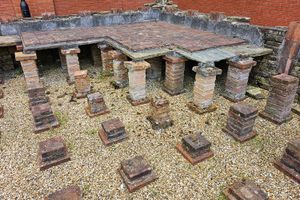
As early as the beginning of the 19th century, historians suspected that the city of Wigan in northwest England had once been the site of some sort of ancient Roman settlement. The location seemed to correspond to the position of a fort on Roman maps, various Roman roads from other known Roman settlements in seemed to lead to Wigan, and an assortment of Roman artifacts had been found in the area over the years.
Excavations in the 1980s uncovered more conclusive evidence that Wigan was an ancient Roman settlement. However, it was not until the early 21st century that people understood the true extent of what lay under Wigan.
In the early 2000s, developers started work in Wigan on a new shopping center to be named the Grand Arcade. Legislation in the 1990s obligated developers to perform an archaeological survey before commencing construction, and when this survey was started on the site in late 2004, materials from both the Roman and Medieval era were found. Additional excavation work in 2005 revealed much more extensive material from the Roman era, much of which dated back to the 2nd century, and eventually, the remains of a Roman bathhouse were unearthed.
The bathhouse appeared to have been erected in the early 2nd century when the site was a Roman military outpost, and based on the sheer scale of the ruins, it was assumed to be a very prestigious site. The most notable finds were three separate hypocausts, which were rooms built with ventilation under the floor that could be used to circulate hot air for heating the rooms above.
The structure also included a possible plunge pool and a substantially large colonnade. However, when the Roman army moved their troops out of Wigan at the end of the second century, the bathhouse was apparently completely dismantled, mainly to deny its use to other people unaffiliated with the Romans. In subsequent centuries, people built over the site, and the bathhouse was forgotten.
Unfortunately, this archaeological site was not preserved by the twenty-first century shopping center developers; construction of the Grand Arcade proceeded once the excavations of the bathhouse and the surrounding area were complete. However, some of the materials from the ruins were used to create a small reproduction of a hypocaust in a quiet area just outside the shopping center. Even with the original ruins gone, this reconstruction provides residents and visitors to Wigan with the opportunity to learn about the city’s ancient past.

